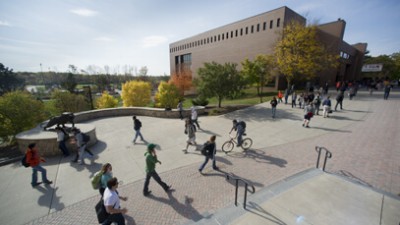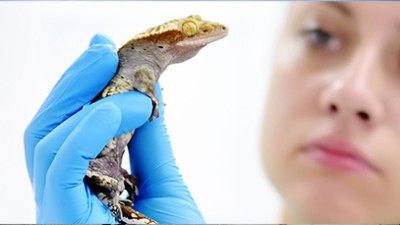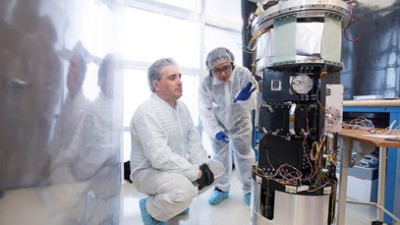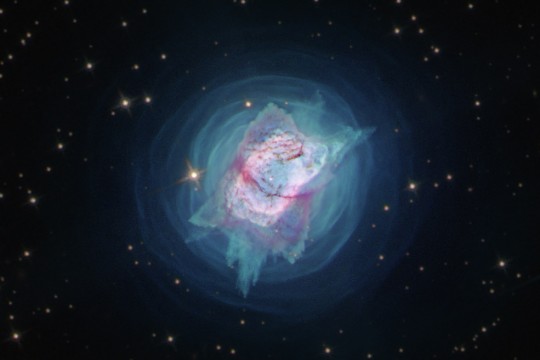News
School of Physics and Astronomy
-
June 18, 2020
![Hubble image of gas and dust ejected from a star.]()
Hubble Provides Holistic View of Stars Gone Haywire
NASA features Joel Kastner, a professor in RIT’s Chester F. Carlson Center for Imaging Science and School of Physics and Astronomy, and astrophysical science and technology Ph.D. students Jesse Bublitz and Paula Moraga on their latest Hubble telescope observations.
-
April 30, 2020
![stars in deep space.]()
How could an explosive Big Bang be the birth of our universe?
Michael Lam, assistant professor of physics and astronomy, explains the Big Bang theory for the "Curious Kids" series published by The Conversation.
-
April 22, 2020
![simulation of the magnetic field lines from a rotating neutron star.]()
NSF funds RIT researchers to develop code for astrophysics and gravitational wave calculations
The National Science Foundation recently awarded researchers at RIT, the University of Illinois at Urbana-Champaign, Louisiana State University, Georgia Tech and West Virginia University grants totaling more than $2.3 million to support further development of the Einstein Toolkit, a community-developed code for simulating the collisions of black holes and neutron stars, as well as supernovas and cosmology.
-
April 2, 2020
![looking up side of brick building at sunny sky.]()
‘U.S. News’ rankings highlight RIT graduate programs
RIT graduate programs are among the best in the nation, according to the U.S. News annual statistical survey of graduate programs. RIT master’s degree programs in engineering, business and fine arts feature in the U.S. News & World Report 2021 edition of Best Graduate Schools, released in March, including the first specialty ranking of the university’s business analytics master’s program.
-
March 31, 2020
![four researchers looking at computer that's analyzing a quantum photonics wafer.]()
Making a quantum leap
Researchers from RIT’s Future Photon Initiative, in collaboration with the Air Force Research Laboratory, have produced the Department of Defense’s first-ever fully integrated quantum photonics wafer.
-
March 9, 2020
![reseacher with view of space on computer screen.]()
RIT professor designated as an American Astronomical Society Fellow
An RIT professor is being honored as one of the first American Astronomical Society Fellows. Joel Kastner, a professor in RIT’s Chester F. Carlson Center for Imaging Science and School of Physics and Astronomy, is part of an initial group of more than 200 Legacy Fellows recently named by the society.
-
February 10, 2020
![Artist's conception of a massive planet orbiting a cool, young star.]()
RIT scientists discover the nearest-known ‘baby giant planet’
Scientists from RIT have discovered a newborn massive planet closer to Earth than any other of similarly young age found to date. The baby giant planet lies only about 330 light years from our solar system. The discovery, published in the Research Notes of the American Astronomical Society, provides researchers an exciting new way to study how gas giants form.
-
December 12, 2019
![large and small satellite dishes.]()
RIT and IAR observe pulsars for the first time from South America
A team from RIT and the Instituto Argentino de Radioastronomía (IAR) upgraded two radio telescopes in Argentina that lay dormant for 15 years in order to study pulsars, rapidly rotating neutron stars with intense magnetic fields that emit notably in radio wavelengths. The project is outlined in a new paper published in Astronomy and Astrophysics.
-
November 20, 2019
![Yellow and purple illustration of black holes colliding.]()
Baby Black Holes May be Orbiting Supermassive Black Holes
Futurism cites research by Richard O’Shaughnessy, assistant professor in the School of Mathematical Sciences.
-
November 18, 2019
![Two researchers wearing cleansuits work on detector equipment.]()
Researchers prepare rocket for launch
A team of RIT researchers is helping launch an experiment above the atmosphere to better understand extragalactic background light, which traces the history of galaxies back to the formation of the first stars in the universe.
-
November 8, 2019
![Simulation of an accretion disk surrounding a supermassive black hole.]()
New study suggests ‘Pac-Man-like’ mergers could explain massive, spinning black holes
Scientists have reported detecting gravitational waves from 10 black hole mergers to date, but they are still trying to explain the origins of those mergers. The largest merger detected so far seems to have defied previous models because it has a higher spin and mass than the range thought possible. A group of researchers, including RIT Assistant Professor Richard O’Shaughnessy, has created simulations that could explain how the merger happened.
-
November 5, 2019
![Professor writes equation on dry-erase board.]()
RIT researchers working to build the basis of life
WROC-TV talks to Moumita Das, associate professor in the School of Physics and Astronomy, about her work with neurons and an NSF-funded project to build synthetic neurons.
















